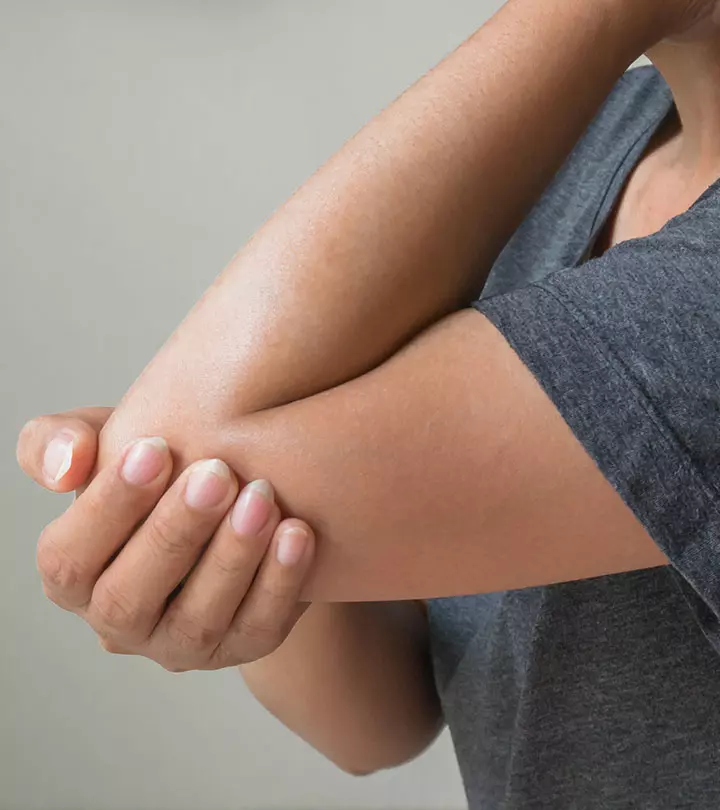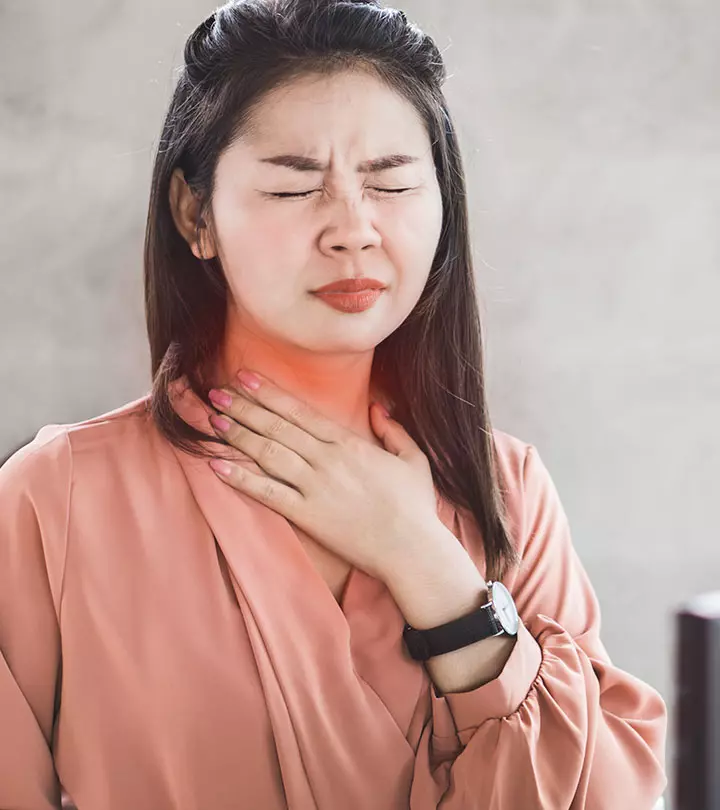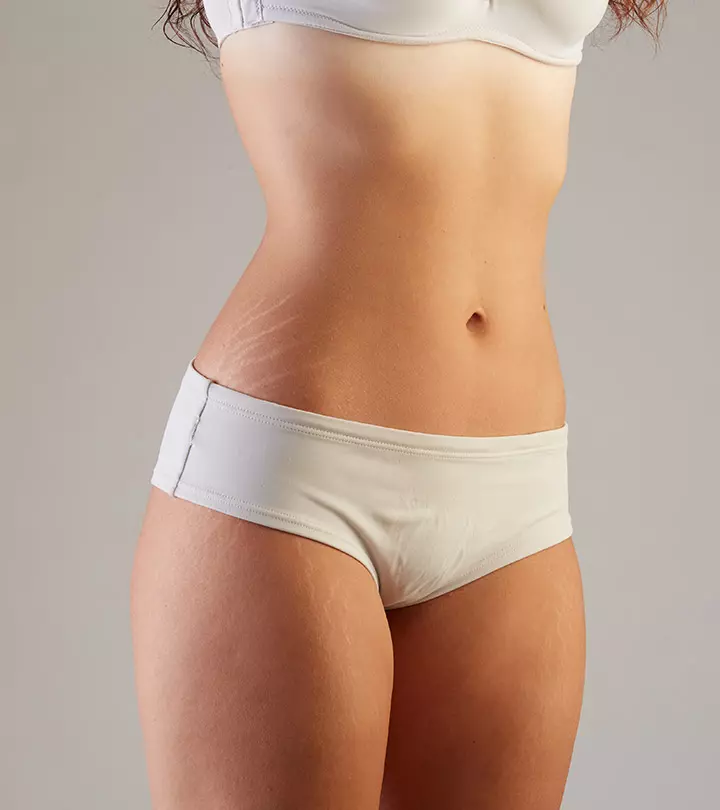Tennis Elbow Home Remedies, Symptoms, Causes, And More
Learn how to manage the excruciating pain with some simple home remedies.

Image: Shutterstock
Tennis elbow develops due to the overuse of the tendons around the elbow joints and the forearms. Although many tennis players develop this condition due to overexertion of their forearm muscles, tennis elbow can affect a person of any age. Even the simple task of writing and cutting vegetables and meat can cause immense pain and distress to the person. In this article, we discuss the symptoms and causes of tennis elbow along with the home remedies one can try to soothe the pain. Scroll down to find out more!
In This Article
What Is Tennis Elbow?
Tennis elbow is medically known as lateral epicondylitis. This condition usually occurs when the tendons in the elbow are overloaded by repetitive motions of the wrist and the arm.
The pain that accompanies tennis or golfer’s elbow usually occurs in the tendons of your forearm, which are attached to the bony bump outside your elbow. This pain can also spread to your forearm and wrist.
A study published in the National Library of Medicine found that 1-3% of the general population develop tennis elbow every year, more likely in the dominant arm. It was further estimated that 50% of tennis players develop symptoms due to wrong technique or the use of heavy rackets.
Other symptoms of tennis elbow are listed below.
Key Takeaways
- Occupations and sports activities that strain your hand muscles can increase your risk of developing tennis elbow.
- Massaging lemongrass oil twice daily on the affected areas can give you pain relief.
- Forearm strengthening exercises can help speed up your recovery.
- You can also opt for acupuncture therapy for quick treatment of your tennis elbow.
Signs And Symptoms Of Tennis Elbow
- Difficulty in shaking hands or gripping an object.
- Ache in the outer elbow.
- This ache may turn into chronic pain if left untreated.
The main cause of tennis elbow is an injury caused by overuse of the muscles and tendons of your elbow.

There are also a few other factors and professions that can increase your risk of developing tennis elbow due to repetitive strain, some of which are discussed below.
What Causes Tennis Elbow?

Some of the most common arm motions known to cause tennis elbow are:
- Use of plumbing tools
- Driving screws
- Painting
- Cutting up ingredients, especially meat
- Repetitive use of the computer mouse
There are also a few risk factors that increase your chances of developing tennis elbow. They include:
- Age: Those between 30 and 50 years of age are at a higher risk of developing tennis elbow.
- Occupation: Those who have jobs that require repetitive motion of the arms and wrists, for example, plumbers, painters, carpenters, cooks, etc., are at a higher risk of developing this condition.
- Certain sports: Engaging in too much of racket sports can also give you tennis elbow.
Understanding the causes of tennis elbow helps ensure an accurate diagnosis and the appropriate course of action to treat the condition. Scroll down to learn how to diagnose tennis elbow.
Diagnosis Of Tennis Elbow
A healthcare provider will start with a physical examination, measuring your range of motion and looking for any elbow pain, especially on the outside. They may ask you to perform certain movements, such as gripping an object, lifting a weight, or extending your arm, to evaluate pain levels and function.
Imaging tests like X-rays or ultrasounds may be suggested in some situations to rule out other illnesses like arthritis or fractures and establish the existence of soft tissue damage. In more severe or chronic situations, MRI scans can also be utilized to examine the soft tissues and tendons surrounding the elbow more closely.
If you have developed this condition, don’t worry. Here is a list of natural remedies that can speed up your recovery.
Home Remedies To Treat Tennis Elbow
- Essential Oils
- Turmeric
- Castor Oil
- Heat Or Ice Pack
- Deep Tissue Massage
- Aloe Vera Juice
- Tart Cherry Juice
- Vitamins
- Fenugreek
- Potato
- Ginger
- CelerySeeds
- Pineapple
How To Treat Tennis Elbow Naturally
1. Essential Oils
a. Lemongrass Oil
You Will Need
- 12 drops of lemongrass oil
- 30 mL of any carrier oil
What You Have To Do
- Mix 12 drops of lemongrass oil with 30 mL of any carrier oil.
- Apply this over your forearm and other aching areas.
- Leave it on for 30 to 60 minutes.
- Wash it off.
How Often You Should Do This
You must do this 1 to 2 times daily.
Why This Works
Lemongrass oil is widely known for its potent anti-inflammatory properties, which can help treat the pain and inflammation associated with tennis elbow (1).
b. Lavender Oil
You Will Need
- 12 drops of lavender oil
- 30 mL of any carrier oil
What You Have To Do
- Add 12 drops of lavender oil to 30 mL of any carrier oil and mix well.
- Apply this mixture to the affected area.
- Leave it on for at least 40 to 60 minutes and then wash it off.
How Often You Should Do This
Do this once daily.
Why This Works
Lavender oil is a multipurpose essential oil that is widely used for healing various ailments.
Its anti-inflammatory and analgesic properties make it the perfect remedy for treating tennis elbow (2).
2. Turmeric
You Will Need
- 1 teaspoon of turmeric powder
- 1 glass of hot milk
- Honey
What You Have To Do
- Add a teaspoon of turmeric powder to a glass of hot milk and stir well.
- When the milk cools down a bit, add some honey to it.
- Consume this mixture while it is warm.
How Often You Should Do This
You must consume turmeric milk 1 to 2 times daily.
Why This Works
Turmeric can work wonders in treating tennis elbow because of the presence of a magic ingredient called curcumin in it. Curcumin not only speeds up healing but also reduces the pain and inflammation to a great extent (3), (4).
3. Castor Oil
You Will Need
- 1 tablespoon of castor oil
- A hot water bottle
What You Have To Do
- Apply a tablespoon of castor oil to your elbow.
- Place a hot water bottle on it and leave it on for 15 to 20 minutes.
- Repeat a couple of times.
How Often You Should Do This
Follow this procedure once daily for a few weeks.
Why This Works
Castor oil contains a compound called ricinoleic acid, which has anti-inflammatory properties (5). These properties, in combination with the heat, reduce the pain and inflammation.
4. Ice Or Heat Pack

You Will Need
Ice or heat pack
What You Have To Do
- Apply an ice pack to the affected area.
- Continue doing this for 15 minutes every couple of hours.
- Do this for the first few days, after which you can apply a heat pack to the affected area.
How Often You Should Do This
You must do this several times a day.
Why This Works
An ice pack can do wonders in treating tennis elbow. Ice therapy not only provides immediate relief from pain but also helps reduce any swelling in the affected area (6). The heat pack helps reduce inflammation (7).
5. Deep Tissue Massage
Deep tissue massage is increasingly becoming popular, thanks to its wide range of benefits. It is commonly used to treat chronic aches and can help you deal with stiff neck, lower back pain, sore shoulders, as well as tennis elbow. This massage therapy uses firm and slow strokes to reach the deeper layers of the muscles and fascia and can help relieve inflammation, pain, and disrupted circulation (8).
 Quick Tip
Quick Tip6. Aloe Vera Juice
You Will Need
1 cup of aloe vera juice
What You Have To Do
Consume a cup of aloe juice daily.
How Often You Should Do This
Start with two cups of aloe vera per day, and once you notice an improvement in your condition, reduce the intake to one cup per day.
Why This Works
Aloe vera juice is one of the best remedies to treat tennis elbow from within. It possesses excellent healing and anti-inflammatory properties that can help reduce pain and swelling (9).
7. Tart Cherry Juice
You Will Need
1 cup of unsweetened tart cherry juice
What You Have To Do
Consume a cup of tart cherry juice.
How Often You Should Do This
Do this 1 to 2 times daily.
Why This Works
Tart cherry juice reduces muscle soreness and inflammation, increases strength, relieves pain, and quickens recovery (10).
 Quick Tip
Quick Tip8. Vitamins

Including certain vitamins in your diet can also speed up your recovery. Vitamins A and C are especially helpful in treating tennis elbow. While vitamin A increases collagen production, which helps repair the torn tissues, vitamin C also promotes cell repair and growth (11), (12), (13).
Some foods that are rich in these vitamins include kiwis, tomatoes, bell peppers, leafy vegetables, carrots, and dairy products. You can also take additional supplements for these vitamins, but only after consulting your doctor.
9. Fenugreek Seeds
You Will Need
- 2 tablespoons of fenugreek seeds
- Milk (as required)
What You Have To Do
- Soak two tablespoons of fenugreek seeds overnight.
- The next morning, grind the soaked fenugreek with just enough milk to form a thick paste.
- Apply this paste evenly to the affected area.
- Leave it on for 1 to 2 hours before washing it off with lukewarm water.
- You can also mix a teaspoon of powdered fenugreek in a glass of warm water and consume it.
How Often You Should Do This
Do this once daily.
Why This Works
Fenugreek has powerful anti-inflammatory activities that help in treating tennis elbow as well as the inflammation accompanies it (14).
10. Potato
You Will Need
- 1-2 boiled potatoes
- A clean washcloth
What You Have To Do
- Boil two potatoes and mash them immediately.
- Place the mashed potatoes in a clean washcloth and tie it up.
- Wrap this washcloth over the affected area.
- Leave it on for 30 minutes.
How Often You Should Do This
You must do this 1 to 2 times daily.
Why This Works
Potato is another ingredient that is used for treating tennis elbow because of its strong anti-inflammatory properties (15). It soothes the inflammation and pain associated with the condition.
11. Ginger
You Will Need
- 1-2 inches of grated ginger
- 1 cup of water
- Honey
What You Have To Do
- Add an inch or two of grated ginger to a cup of water.
- Bring it to a boil in a saucepan and simmer for 5 minutes.
- Strain and add a little honey.
- Consume the ginger tea while it is warm.
- You can also soak a washcloth in ginger tea and apply it to the affected area.
How Often You Should Do This
Consume ginger tea thrice daily.
Why This Works
Given the powerful analgesic and anti-inflammatory properties of ginger, it is no surprise that it is used to treat a variety of ailments, especially related to sports injury, including tennis elbows (16), (17).
12. Celery Seeds

You Will Need
- 1 teaspoon of celery seeds
- 1 glass of warm water
What You Have To Do
- Extract the juice from a teaspoon of celery seeds.
- Add 10 drops of this extract to a glass of warm water and mix well.
- Consume this mixture.
How Often You Should Do This
You must drink this mixture 2 to 3 times daily, preferably before every meal.
Why This Works
Celery extract possesses anti-inflammatory properties that can help in dealing with the pain, inflammation, and swelling associated with tennis elbow (18).
13. Pineapple
You Will Need
1 bowl of freshly cut pineapples
What You Have To Do
- Consume a bowl of freshly cut pineapples.
- Alternatively, you can also blend the cut pineapples and consume the juice.
How Often You Should Do This
Do this 1 to 2 times daily.
Why This Works
As we have already discussed, vitamin C enhances collagen production and helps in speeding up your recovery. Pineapple is not only a rich source of vitamin C, but it also contains an enzyme called bromelain, which has anti-inflammatory and analgesic properties – both of which are great for curing tennis elbow (19), (20), (21).
These remedies will give you the desired results and help you in getting rid of tennis elbow successfully. You may further accelerate recovery by trying out some simple forearm exercises at home. Check them out below!
Exercises For Tennis Elbow
Try out these convenient tennis elbow exercises at home, without any equipment. You just need a rolled-up towel and a half-liter bottle.
- Fist Clench
- Hold a rolled-up towel in your hand and squeeze it for 10 seconds before releasing.
- Do 10 repetitions with both hands.
- Wrist Extension
- Hold a half-liter bottle, keeping the palm facing down.
- Curl just your wrist toward your body and back up. You may do this with an empty fist if the weight feels challenging.
- Repeat 10 times with both hands.
- Wrist Flexion
- Similar to wrist extension, except this time your palm faces upward when you curl your wrist toward your body.
- Repeat 10 times with both hands.
Tony Bapuji, a business consultant and blogger, recounted his struggle with tennis elbow and explained how he recovered. He writes, “My first physiotherapist gave me some exercises with a resistance band. These worked at first. I also got relief by wrapping my elbow in a small, damp tea towel heated in a microwave. But I was a bit complacent and didn’t do it regularly enough. I also strengthened my shoulder with a stronger resistance band (i).”
Pair these remedies and exercises with some lifestyle changes to avoid the recurrence of tennis elbow. Here are a few tips.
Prevention Tips

- Avoid straining your elbows.
- Find the activity that is causing the tennis elbow and find an alternative to it.
- Get training from professionals to avoid any stiffness and discomfort before indulging in sports like tennis or squash.
- Always warm up before any intense exercise to increase your range of motion.
- Do exercises that help to strengthen your forearm muscles, like stretching and dumbbell curls.
- Get an acupuncture treatment from a professional.
- Wear a tennis elbow band or brace.
- Do forearm stretching and strengthening exercises to accelerate recovery.
- Make sure you give yourself plenty of time to rest to avoid further inflammation and pain.
Most medical conditions require immediate treatment or surgery to prevent them from taking a complicated turn. Hence, it is best to treat this condition at the earliest to avoid complications that may even lead to surgical intervention. You might be prescribed a course of corticosteroids to reduce inflammation.
Hope you find this article helpful in treating tennis elbow. For further queries and feedback, please use the comments box below.
Infographic: 5 Ways To Treat Tennis Elbow Naturally
Engaging in racket sports too often or repeated use of plumbing tools may cause tennis elbow. This may result in difficulty in gripping objects and pain in the outer elbow. While medical treatment may be necessary, you also can make use of simple and natural solutions to reduce the pain. Check out the infographic below for more information.
Some thing wrong with infographic shortcode. please verify shortcode syntaxTennis elbow refers to a condition characterized by pain and aches in the tendons of the forearms, especially the elbow. It may affect anybody prone to using repetitive movements of that part. Some classic symptoms of tennis elbow include difficulty grabbing objects, shaking, and persistent pain if left untreated. Fortunately, there are quite a few effective remedies for tennis elbow, including essential oils like lemongrass and lavender and natural ingredients like turmeric, fenugreek, turmeric, potato, and ginger. To prevent the development of tennis elbows, you need to avoid straining your elbows, strengthen your forearms with appropriate exercises, and practice warm-up before intense exercises. Rehabilitation and physiotherapy are two other ways to ensure that your injured arm gets proper care and treatment along with a chance to avoid it in the future. You can also opt to wear an elbow band or brace to reduce impact and injury.
Frequently Asked Questions
Why is my tennis elbow not healing?
Tennis elbow can take anywhere from weeks to months to heal completely. This is because the injured tendons take quite a bit of time to heal. However, you can speed up your recovery by following the remedies listed in this article.
How long does it take to recover from tennis elbow?
For certain individuals, it might heal in as early as a week. However, in a few others, it might take a few months or years to heal completely.
What is the best support for tennis elbow?
If you are looking for support for your injured elbow tendons until they heal completely, it is best to invest in a therapeutic elbow brace or strap.
How to avoid developing tennis elbow while playing tennis?
You can avoid developing tennis elbow while playing tennis by applying less pressure on your wrists and elbows. Instead, you can spread the load to the muscles of your shoulders and upper arms.
Is swimming good for tennis elbow?
No. Swimming is one of the activities known to trigger this condition. Hence, you must avoid it until you recover completely.
Does squeezing a ball help treat tennis elbow?
Yes, squeezing a ball is a form of strengthening exercise that helps improve grip strength and soothe the affected muscles.
Is tennis elbow a form of arthritis?
No, the two are separate medical conditions. Arthritis is caused due to inflammation of the joints.
Is Epsom salt good for tennis elbow?
Possibly. Epsom salt may help soothe the inflammation and any swelling. It also helps relax the muscles.
Can a chiropractor fix a tennis elbow?
Yes. Your chiropractor will examine your pain and look for adjustments to the elbow and wrist that increase joint mobility and reduce joint compression and inflammation.
Illustration: Tennis Elbow Home Remedies, Symptoms, Causes, And More

Image: Dall·E/StyleCraze Design Team
Learn more about the top 3 exercises that help relieve the pain caused by tennis elbow. Check out the video below for tips on how to reduce inflammation and strengthen the elbow muscles.
Personal Experience: Source
StyleCraze's articles are interwoven with authentic personal narratives that provide depth and resonance to our content. Below are the sources of the personal accounts referenced in this article.
i. Tennis Elbow and I don’t even play tennis!https://medium.com/@tonybapuji/tennis-elbow-and-i-dont-even-play-tennis-cce40bc7f028
Read full bio of Dr. Sudhansu Singh
Read full bio of Shaheen Naser
Read full bio of Arshiya Syeda
Read full bio of Dipti Sharma



























Community Experiences
Join the conversation and become a part of our empowering community! Share your stories, experiences, and insights to connect with other beauty, lifestyle, and health enthusiasts.